Six More Absurdly Difficult D&D Adventures (That Are Not 'Tomb of Horrors')
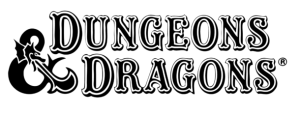
Before getting started, I have just one thing to say: you're a bunch of sadists. All of you. I compiled a list of half a dozen of the deadliest old school Dungeons & Dragons adventures to ever see print, and you not only ate it up but shared it with your buddies and gave it enough upvotes to strongly suggest I produce a sequel.
So be it.
No saving throws, no take-backs, just six more ways you can humiliate, demoralize, and melt your players with nothing more than a quick trip to eBay or DriveThruRPG. And again, no Tomb of Horrors. Obvious meat grinder is obvious, and it's more fun to vivisect characters when neither they nor their players suspect what's about to go down. Just don't come crying to me when your gaming group turns into something you'd read about over at John Wick's blog, with players unleashing the real-life somatic components for Bigby's Extended Middle Finger and Tasha's Uncontrollable Hideous Swearing on you like free actions.
Note: this is an edited republication of an article I originally wrote for Retro Gaming Magazine. You can read it in its original form here.
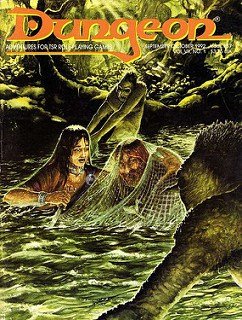
6) "The Mud Sorcerer's Tomb" by Mike Shel (Dungeon Magazine, #37)
It's somehow fitting such a deadly adventure should have such a bizarre title. You know this one's going to get medieval on your ass just by reading the author's note and introduction, where Shel tips his hat not only to Tomb of Horrors but also White Plume Mountain, Hidden Shrine of Tamoachan, and The Forgotten Temple of Tharizdun.
He goes on to provide a few more suggestions:
- 6-8 characters of 10-14 levels
- high-level spellcasters recommended
- dexterous thief a plus
- warriors handy
- clerics with access to Neutralize Poison a must.
Assuming your PCs' resumes reflect a bulk of these traits, the tomb of the Mud Sorcerer stands ready...to bury them alive anyway. It's for second edition AD&D as presented in the magazine, but Paizo updated it to 3.5 rules in issue 138 (grab the free PDF supplement with maps, illustrations, and other things here), and Wizards of the Coast made it the poster child for 5th edition rules playtesting with some, uh, decidedly mixed results...
Spoiler-Free Summary:
If the first question out of your players' mouths isn't, "What the hell is a Mud Sorcerer?" you're probably dealing with old-school grognards, and should assume at least some of them are familiar enough to bend the dungeon over the proverbial sawhorse. On the other hand, if anybody in the group pipes up demanding to know what a mud sorcerer is, try to avoid a larger-than-normal amount of teeth in your grin, thus giving away the ass-whupping they're about to experience.
Mud Sorcerers were so named due to their focus on water and earth elemental magic, but this wasn't a badge of honor -- it was a moniker of ridicule from those who opposed and/or feared them. Shel goes deep into their history and background, but their basic plan was to dig these huge underground caverns where they could wait in temporal stasis until the political climates above shifted more to their favor and the factions united against them would become embroiled in their own chaos, eventually forgetting the mud sorcerers. They would then emerge, crush whatever was left of their enemies, and reign supreme. The first part of their plan worked perfectly, and dozens of mud sorcerers built their own dungeons, grottoes, and other muck-filled resting places. Instead of in-fighting though, once the most powerful mud sorcerers went to ground, the factions all aligned against what was left of the group, hunted down their followers, and destroyed everything associated with them in an effort to wipe them from history's memory.
In this, they succeeded spectacularly, as nobody today has a clue what mud sorcerers are or were.
Before you throw the victory party though, realize that means anybody entering a mud sorcerer's resting place today is going in blind, reliant only on folklore passed down through history and whatever they're willing to pay sages to research a group of mages defunct for nearly seven centuries. It looks like a new tomb has been uncovered, and the PCs get first dibs on the action. What follows is a multi-hour play session filled with enough drowning, suffocation, animated statues, and giant mummies to ensure your erasure from everybody's Christmas card lists.
Best Sprung On:
Players who asked, "What's a mud sorcerer," obviously.
Kidding aside, this is one of the most highly-regarded adventures to appear in Dungeon magazine, and the fact it's been revised twice means it's less likely to have fallen off your players' radar than some of the others in this article. Shel counsels it's more for thinkers than slayers, and I whole-heartedly agree: brute force can overcome some enemies, but there are more obstacles for engaging the brain than exercising the sword arm. A mere 36 encounter areas, but don't let its size fool you; those areas are packed with enough acid, poison, water, and douchebaggery to shame Pi Kappa Alpha. Considering they once held an open press conference to repeatedly deny allegations of butt-chugging among fraternity members, that's not a statement I make lightly.
A tip of the hat to Shel though, as the final encounter with the mud sorcerer who built the place is memorable for reasons no PC or player will see coming. Opinion on this is divided, but I loved the reveal because it's something most adventure authors wouldn't have the guts to try. Best of all, Mud Sorcerer's Tomb is campaign-agnostic, so drop it anywhere into your own world and start giving your players fits today!
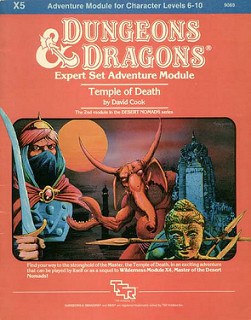
5) "Temple of Death" by David "Zeb" Cook
There's being straightforward, and then there's calling your adventure "Temple of Death". X-coded modules were meant for the eXpert-level characters in D&D; once you graduated from the Basic series, written for characters of 1st-3rd level, you should be ready to tackle the next tier. X5: Temple of Death and its precursor X4: Master of the Desert Nomads are connected adventures, but they can be played as one-offs with some minor tweaks. Just like Tomb of Horrors, Temple of Death does what it says on the label, with no rainbows or unicorns to break up the butt-kickings.
Spoiler-Free Summary:
Nomadic tribes are generally small enough to pose no threat to other nations, but someone known only as "The Master" has united the clans under his bannerin preparation for all-out war. The only chance civilization has to stand against the incursion is to slip a small group, undetected, into the Master's sanctuary where they can wreak havoc on the would-be invaders and put an end to the his, or her, or its, plans. Naturally there's a reason the place is known as 'The Temple of Death'... Probably something having to do with all the nasty, horrible ways it includes for PCs to meet their makers, if I had to venture a guess. Given this adventure is for a party of 6th to 10th level characters, think of it as Tomb of Horrors lite: all the fatalities, half the calories.
Best Sprung On:
If there's a Venn diagram to describe the ideal victims for David Cook's demented designer pen, it's the overlapping cross-section of:
- A) PCs who previously completed Master of the Desert Nomads and
- B) Groups who think they could teach Solid Snake a thing or two about tactical espionage action.
Cook reminds the DM repeatedly that the players are there to infiltrate, not exterminate. Parties who think the answer to everything is "I waste it with my crossbow!" will quickly find themselves running out of both ammunition and healing potions. That doesn't mean careful parties are in for a cake-walk, it just means PCs need to have their heads screwed on straight to have even a ghost of a chance to succeed. Even a well-armed, well-prepared party can walk into multiple TPK (Total Party Kill) situations before they get anywhere near the Temple (my favorite being a pack of Spectral Hounds that pursue the party doggedly until they've been evaded successfully for several nights in a row). Cook also provides multiple contingencies for the Temple residents regarding the behavior of any would-be invaders. There are dozens of ways a single careless act can result in catastrophic failure, up to and including capture, abduction, imprisonment, interrogation, torture, and execution. Hell, it's possible to infiltrate the temple, kill the Master, slip out a secret exit in the ensuing chaos, and still fail the mission. Cook recommends using the seven pre-generated characters at the back of the module for this one, and I agree. Seeing a nameless nobody sold into slavery to gnolls hurts far less than watching it happen to a carefully-nurtured and beloved character.

4) "The Forgotten Temple of Tharizdun" by Gary Gygax
If anybody should know killer dungeons, it's Gary "You're Goddamn Right I Wrote Tomb of Horrors" Gygax. But while ToH is a meat grinder, WG4: The Forgotten Temple of Tharizdun is something even worse: a psyche grinder. Players can walk away from the table post-Tomb with their sanity still intact. Tharizdun is meant to get under the skin and into the brain; if you aren't ruminating on what your party did after the adventure's conclusion, you either didn't have the right DM or you missed the last portion of the module. After Mud Sorcerer's Tomb, this is the module most readers nominated for an appearance in a follow-up article. Their wish is, whole-heartedly, my command. WG4 is a beast.
Spoiler-Free Summary:
While out searching for the Lost Caverns of Tsojcanth, (a module with which WG4 is written to interface) the party discovers Gnome Vale, and is cautiously welcomed as adventurers. Gnome Vale is a peaceful, content oasis in the midst of a harsh mountain range, but they have a problem: Groorg won't leave them alone. Groorg, it turns out, is a giant, and a relatively intelligent one at that. Having forged an alliance with a number of smaller groups involving them working for him in exchange for the wages of 'not being eaten', Groorg's turned a nearby temple ruins into a heavily-fortified outpost. Raiding parties frequently target Gnome Vale, carrying off food, livestock, and the occasional luckless gnome. The valiant little folk mount a swift defense which always turns the tide and prevents disaster, but their community is in danger of being overrun if these attacks continue as Groorg's forces grow fiercer and bolder with each incursion. Eager to pay back the hospitality shown them by the gnomes, the PCs pledge to find Groorg's lair and put an end to the pillaging once and for all. And if they think this is nothing more than a straight-forward dungeon crawl, then you've got your players right where you want them.
The temple Groorg's taken over has a dark history dedicated to the worship of a long-forgotten deity, suffused with evil that not even the centuries have diminished. While the giant and his minions are mostly content to remain in the upper portions of the temple, their excursions into the lower levels are stirring the pot, so to speak. And nobody, not Groorg, not his minions, not the gnomes, and definitely not the players, is going to like what's bubbling to the surface.
Best Sprung On:
Teams who aren't afraid to employ a healthy dose of strategy in what starts out a simple offensive and will likely turn into a protracted siege unless they're exceptionally skilled and fortunate. What makes Tharizdun an undertaker's delight is the speed with which it can turn from a slaughter-fest in favor of the PCs into one favoring the enemy. The upper level of the temple is almost criminally simple, even the least-prepared group should be able to handle it assuming they're within the module's level range; it's not until the bigger nasties start rolling up out of the depths that the PCs begin to realize the full extent of the problem. This creates a quandary: does the group push forward to capitalize on its gains in hopes of establishing a foothold on the place, or do they pull back and regroup knowing everybody's now on high alert and allowing the temple's inhabitants to rally together and stage a stronger defense? It's a classic Gygaxian fork of "heads I win, tails you lose", and that's why this one is ideally played with the DM encased in a bubble of bullet- and soda-proof Plexiglas.
Of course, that's only the first half of the scenario. PC's might well wipe out the giant, cleanse the halls of his norker minions, and never stumble into the Undertemple. Maybe that's for the best, but assuming they do come across it in their travels, the real fun begins as Tharizdun's corruption is strongest here. For the PCs to advance, they will have to perform some dark rituals (hello, alignment checks!) and what they discover in the Black Cyst may not prove worth the risks. PCs who die down here will have only themselves and their insufferable curiosity to blame, and those who make the descent prepared to face off with a "final boss" of some sort are in for quite the shock. This is bloody, creepy, insidious fun for a DM with a flare for the cinematic and atmospheric.
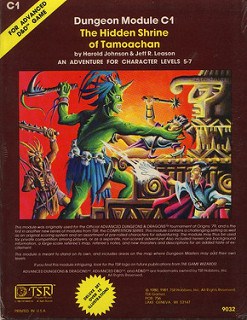
3) "The Hidden Shrine of Tamoachan" by Harold Johnson & Jeff Leason
Modules written for tournament settings aren't exclusively killer dungeons, but if the purpose of running your adventure is to separate the wheat from the chaff, putting together one with multiple ways to separate the PCs' heads from their bodies is a fine start. The most effective way is to throw both the players and their characters into completely unfamiliar situations with no option of retreat. Dropping in a time limit further increases the pressure of the boots on your players' necks. Don't let that 5th - 7th level range fool you: Johnson and Leason's baby is still crammed with enough misery to inspire its own Stephen King novel.
Spoiler-Free Summary:
Holy in media res, Batman! The PCs are on the run from a superior force out to capture them at all costs. Ditching the boat and hiding in the jungle seemed like a good idea at the time, and it's led to a clearing. What's that over there...some kind of pyramid? Who cares -- night's falling, and there's no time to waste. Any port in a storm, right? What's the worst that could happen? Wait, everything's caving in...oh shi-!
After picking themselves up and dusting themselves off, the PCs receive both good news and bad news. The good news: they've eluded their pursuers (hooray!). The bad news: they're stuck underground in the Shrine of Tamoachan, where the air itself conspires to add their corpses to its already-impressive collection. Between room one and freedom is a hideous mixture of unfamiliar enemies, traps, and generally-unpleasant things.
Best Sprung On:
Those sorts who know better than to go poking around in a place called "The Tomb of Horrors", characters too inexperienced for an adventure at that level, or players too inexperienced to tackle it. Tamoachan starts manhandling PCs from the get-go, and never lets up. It not only neuters a typical party's offensive line with a rule about how much of the place falls down around people who start slinging Fireballs and Lightning Bolts like it's the 5th of July and all the fireworks were marked down to buy 1 get 3 free, but also begins poisoning them the minute they take their first breaths. The air in the shrine is mildly toxic, leaving characters a matter of an hour or two to escape before they start dropping dead of asphyxiation. I wasn't kidding about that time limit, and part of your job as DM is to inform your beleaguered players they've all dropped dead if they fail to find the exit.
The potential for a TPK begins a few rooms in where a missed or failed 'find traps' roll will expose the party to a gas of dreadful sleep, potentially rendering everybody unconscious for a period of 5,000 years and making me wonder if Leason and Johnson understood what 'overkill' means. Many of the shrine's floors, walls, and ceilings are covered in lime, and most of the water in the shrine is contaminated with the stuff as well, leading to plenty of incidental damage opportunities along the way. The icing on the cake? Being a tournament module meant for a single-session's play with disposable pre-gens, there's not only very little treasure in the Shrine, but what is available cannot possibly make up for the abuse the characters suffer on their way to the exit (although the fighter's gift from encounter 42 is admittedly awesome). All the adventures on this list and the previous one are killer, but while most are of the instantly-lethal variety, Tamoachan prefers to murder via a 'death of 1,000 cuts' method to prolong the agony. Mud Sorcerer's Tomb and its ilk are brutal; Hidden Shrine of Tamoachan is downright callous. Let your players use pre-gens in here...the alternative may cause them to take up torture as a part-time hobby with you as their full-time victim.
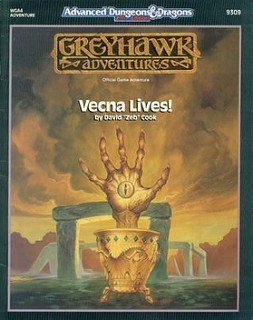
2) "Vecna Lives!" by David "Zeb" Cook
It was pointed out (rightly, I might add) that if one puts Die, Vecna, Die! on a list of difficult adventures, it's only considerate to include the precursor that made Bruce Cordell's contribution possible. Point taken: Vecna Lives! deserves its rightful place on this roll-call. You'll also notice this is the second time Cook's name shows up here. Fitting that, considering he was dreaming up ways to turn PCs into spirit-wracked husks long before Cordell took up the mantle of TSR's Chief Blood Sausage Maker. Released to coincide with the 2nd anniversary of AD&D's second edition, this was Cook's excuse to Rambo out and give DMs, players, and PCs a war they wouldn't believe. Much like Die, Vecna, Die! did for 2E, Vecna Lives! can serve as a way for a DM to cap a long-running 1E campaign and wreck the world just enough to warrant a total reboot, either into a greatly-altered Greyhawk or a completely different setting such as Ravenloft, Planescape, or Forgotten Realms.
Cook's take on this is 96 pages of no-punches-pulled, no-holds-barred savagery. It sets its tone early on, with Cook admitting on page 3:
If your idea as Dungeon Master is that everybody should have fun at game night, David Cook demands the surrender of your Gamer Card. Shit's about to get more real than a back-to-back-to-back Human Centipede marathon. Much like Chris Pramas and Jason Carl in The Apocalypse Stone, Cook encourages the DM to tell as many bald-faced lies to the players as necessary: don't mention 'Vecna', don't tell them the name of the adventure, and if they question you or catch you in the deception, deny everything like you're the target of a Senate Intelligence Committee probe.
Spoiler-Free Summary:
Everybody on Oerth knows the story of the arch-lich Vecna, his lieutenant Kas the Destroyer, and the betrayal which inadvertently created two of the nastiest, deadliest, and most powerful relics of the entire D&D corpus: the Hand and Eye of Vecna. Needless to say, people take reports Vecna might have returned from the dead seriously. Mordenkainen's dispatched The Circle of Eight, a group of the most powerful mages in Greyhawk, to investigate a growing evil presence that has the one-handed, one-eyed one written all over it. When they don't come back, it falls to their proteges (the players, either using the pre-gens as Cook recommends, or their own 12th - 15th level characters) to pick up the trail and get to the bottom of things. Assuming their investigative skills are up to the task, they'll follow a trail of ruin and misery halfway across the Flanaess in pursuit of their quarry, only to learn sometimes it's best not to find what you're looking for, especially if it's going to result in the kind of deity-fueled deathmatch that gives damn near every major and minor power of Greyhawk a reason to NOPE! right the hell out of there like Omar was coming.
Best Sprung On:
Vecna Lives! gets a bad rap for its linearity, and accusations of player railroading aren't without merit. That said, Cook mentions at the start the adventure is more akin to playing a movie with the DM as scene-setting director. This is an exercise in the role- part of role-playing, with far more brainwork than dice-slinging required of the players. It's treading very close to the territory staked out by White Wolf in their products, where the characters are very much there to help tell a story instead of just playing a game. If your group is down for these types of activities, everyone will have a gas and you'll have a story to tell for years that will bore everyone within earshot who doesn't understand why you like that "are-pee-gee" shit.
On the other hand, if your group tends towards the "hurl Fireballs until it fails its saving throw" school, or has a larger-than-normal number of Paladins, give this one a wide berth. The former won't survive long enough to even figure out what happened to the Circle of Eight, and the latter will start planning your fiery demise once they realize the price they're going to pay just for a chance to stop Vecna's machinations.
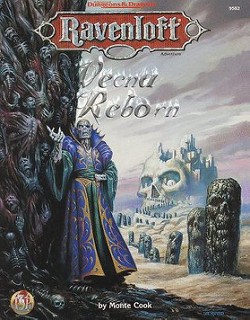
1) "Vecna Reborn" by Monte Cook
What the Nine Hells is up with people named 'Cook' writing adventures capable of crushing even the most well-prepared PCs into freshly-ground fertilizer? Monte Cook (no relation) builds on David Cook's scenario by outlining what comes next for the Maimed One. If you're familiar with the Ravenloft setting, then you know your PCs are in for some Freddy Krueger-level nightmares. Having Monte Cook's name on the cover's a give-away that your players had better don their thinking caps. Vecna Reborn isn't a campaign-ending shitstorm like Die, Vecna, Die!, nor is it the apocalyptic slug-fest of Vecna Lives!...it's even more insidious. Like its predecessor, Vecna Reborn instructs the DM to lie his fool head off and make sure the players never even think the name 'Vecna' before they encounter it for themselves over the course of play.
Spoiler-Free Summary:
Following his exile to the Demiplane of Dread at the conclusion of Vecna Lives!, a place where even a mighty lich lord is bound by the rules, Vecna spends his days plotting and scheming. In what is either the height of irony or the pinnacle of karmic justice, Kas the Betrayer owns his own little piece of real-estate in the misty world of Ravenloft...right next door to Vecna. Obsessed with destroying his old master, Kas farms the citizenry of his domain into a militia, trained and brainwashed to throw themselves into combat with Vecna's forces without regard for their lives. Vecna meanwhile has no fear of Kas's petty bullshit, but resents the continued interruption of his own work. While escape from Ravenloft is thought impossible, Vecna's found a loophole. He's a short time away from putting the ritual into motion when the PCs are drawn to Ravenloft, the only wrench available to be thrown into the works. But these PCs aren't mighty heroes of legend with Wish spells crowding their brains and +10 broadswords of demigod castration lining their Girdles of Storm Giant Strength. What chance has a small group of 5th to 7th level characters against the mists of Ravenloft, much less an undead god hell-bent on breaking out of his cage?
Good question. Maybe they'll figure it out before Act III.
Best Sprung On:
Players who understand their limitations and have no problem working within them. While the heroes of Vecna Lives! (and later Die, Vecna, Die!, assuming they survive that long) are high-level powerhouses capable of weathering a botched die roll or two, Monte Cook wrote this specifically for a small group of mid-level characters. Survival in Ravenloft calls for a certain alteration to traditional playing styles: much like in an H. P. Lovecraft tale, players choosing to rely on brute force over subterfuge will quickly find their insides on the outside -- Ravenloft suffers fools the way I tolerate people who steal my food at work. While the PCs are the saviors of the day, their lack of strength and skill in the face of overwhelming odds threatens them (not emptily) with ferocious beat-downs at every turn. Out-numbered and out-matched, only the most intelligent and cunning players have a prayer of survival. If your group is capable of overriding their heroic instincts to intervene in every situation where obvious evil is taking place, if they can resist the urge to burn time getting side-tracked righting every wrong they see now, and instead muster their patience and resources to deal a more decisive blow in the name of good later, they'll enjoy Vecna Reborn. If they assume the DM is on their side or forget how fragile a group of 7th-level PCs is in the Demiplane of Dread, make sure they have their Player's Handbooks nearby and you have your Dungeon Master's Guide at hand -- they'll be accessing the 'character creation' part of chapter one sooner rather than later, and you'll need something solid to fend off all the hurled polyhedrons.
All right you lot of blood-thirsty maniacs. Does this satiate your appetites for ways to dominate your players and remind them who's boss? Are you entertained? Do we need a Part 3? If so, feel free to berate me for leaving off your favorite PC-mincing module. Effusive praise, upvotes, and re-steems are also acceptable. This being the internet, I have no illusions about which is more likely. I survived these adventures, so by all means: do your worst and do it slow.
This post has received a 2.01 % upvote from @booster thanks to: @teamgreen.